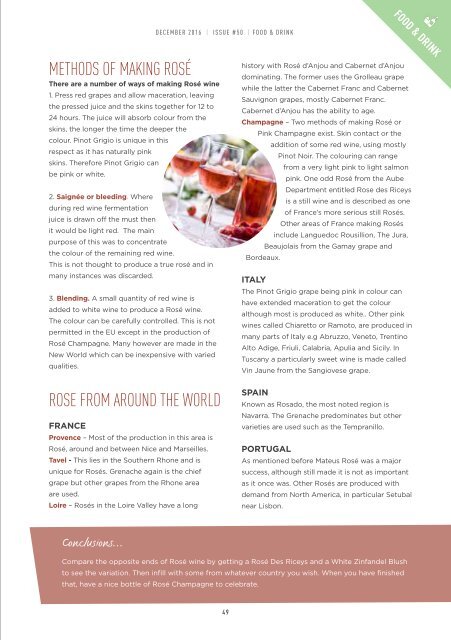Bounce Magazine December 2016
Featuring Sting in our Christmas Edition! With reviews on Satis House, Hotel Chcololat and The Northgate in Bury St Edmunds.
Featuring Sting in our Christmas Edition! With reviews on Satis House, Hotel Chcololat and The Northgate in Bury St Edmunds.
You also want an ePaper? Increase the reach of your titles
YUMPU automatically turns print PDFs into web optimized ePapers that Google loves.
FOOD & DRINK<br />
DECEMBER <strong>2016</strong> | ISSUE #50 | FOOD & DRINK<br />
METHODS OF MAKING ROSÉ<br />
There are a number of ways of making Rosé wine<br />
1. Press red grapes and allow maceration, leaving<br />
the pressed juice and the skins together for 12 to<br />
24 hours. The juice will absorb colour from the<br />
skins, the longer the time the deeper the<br />
colour. Pinot Grigio is unique in this<br />
respect as it has naturally pink<br />
skins. Therefore Pinot Grigio can<br />
be pink or white.<br />
2. Saignée or bleeding. Where<br />
during red wine fermentation<br />
juice is drawn off the must then<br />
it would be light red. The main<br />
purpose of this was to concentrate<br />
the colour of the remaining red wine.<br />
This is not thought to produce a true rosé and in<br />
many instances was discarded.<br />
3. Blending. A small quantity of red wine is<br />
added to white wine to produce a Rosé wine.<br />
The colour can be carefully controlled. This is not<br />
permitted in the EU except in the production of<br />
Rosé Champagne. Many however are made in the<br />
New World which can be inexpensive with varied<br />
qualities.<br />
ROSE FROM AROUND THE WORLD<br />
FRANCE<br />
Provence – Most of the production in this area is<br />
Rosé, around and between Nice and Marseilles.<br />
Tavel - This lies in the Southern Rhone and is<br />
unique for Rosés. Grenache again is the chief<br />
grape but other grapes from the Rhone area<br />
are used.<br />
Loire – Rosés in the Loire Valley have a long<br />
history with Rosé d’Anjou and Cabernet d’Anjou<br />
dominating. The former uses the Grolleau grape<br />
while the latter the Cabernet Franc and Cabernet<br />
Sauvignon grapes, mostly Cabernet Franc.<br />
Cabernet d’Anjou has the ability to age.<br />
Champagne – Two methods of making Rosé or<br />
Pink Champagne exist. Skin contact or the<br />
addition of some red wine, using mostly<br />
Pinot Noir. The colouring can range<br />
from a very light pink to light salmon<br />
pink. One odd Rosé from the Aube<br />
Department entitled Rose des Riceys<br />
is a still wine and is described as one<br />
of France’s more serious still Rosés.<br />
Other areas of France making Rosés<br />
include Languedoc Rousillion, The Jura,<br />
Beaujolais from the Gamay grape and<br />
Bordeaux.<br />
ITALY<br />
The Pinot Grigio grape being pink in colour can<br />
have extended maceration to get the colour<br />
although most is produced as white.. Other pink<br />
wines called Chiaretto or Ramoto, are produced in<br />
many parts of Italy e.g Abruzzo, Veneto, Trentino<br />
Alto Adige, Friuli, Calabria, Apulia and Sicily. In<br />
Tuscany a particularly sweet wine is made called<br />
Vin Jaune from the Sangiovese grape.<br />
SPAIN<br />
Known as Rosado, the most noted region is<br />
Navarra. The Grenache predominates but other<br />
varieties are used such as the Tempranillo.<br />
PORTUGAL<br />
As mentioned before Mateus Rosé was a major<br />
success, although still made it is not as important<br />
as it once was. Other Rosés are produced with<br />
demand from North America, in particular Setubal<br />
near Lisbon.<br />
Conclusions...<br />
Compare the opposite ends of Rosé wine by getting a Rosé Des Riceys and a White Zinfandel Blush<br />
to see the variation. Then infill with some from whatever country you wish. When you have finished<br />
that, have a nice bottle of Rosé Champagne to celebrate.<br />
49


















